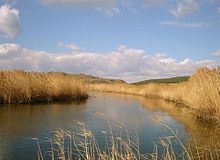Myrina (Aeolis): Difference between revisions
Disambiguated: Syncellus → George Syncellus |
m →External links: correcting link to correct album |
||
| Line 62: | Line 62: | ||
==External links== |
==External links== |
||
{{commons category|Terracotta figurines from Myrina}} |
{{commons category|Terracotta figurines from Myrina}} |
||
*[http://www.asiaminorcoins.com/gallery/thumbnails.php?album= |
*[http://www.asiaminorcoins.com/gallery/thumbnails.php?album=10 asiaminorcoins.com], Ancient coins of Myrina |
||
{{Ancient settlements in Turkey}} |
{{Ancient settlements in Turkey}} |
||
Revision as of 07:55, 30 October 2013
Μυρίνα Template:Grc icon | |
 | |
| Location | Aliağa, Izmir Province, Turkey |
|---|---|
| Region | Mysia |
| Type | Settlement |
| History | |
| Associated with | Agathias |
Myrina (Ancient Greek: Μυρίνα), was one of the Aeolian cities on the western coast of Mysia, about 40 stadia to the southwest of Gryneion.[1] Its site is believed to be occupied by the modern Sandarlik at the mouth of the Koca Çay.[2]
History

It is said to have been founded by one Myrinus before the other Aeolian cities,[3] or by the Amazon Myrina.[4] Artaxerxes gave Gryneium and Myrina to Gongylus, an Eretrian, who had been banished from his native city for favoring the interests of Persia.[5]
Myrina was a very strong place,[6] though not very large, and had a good harbor.[7] Pliny[8] mentions that it bore the surname of Sebastopolis; while, according to Syncellus, it was also called Smyrna. For some time Myrina was occupied by Philip V of Macedon; but the Romans compelled him to evacuate it, and declared the place free.[9] It twice suffered severe earthquakes; first in the reign of Tiberius,[10] on which occasion it received a remission of duties on account of the loss it had sustained; and a second time in the reign of Trajan.[11] The town was restored each time, and continued to exist until a late period.[12] Myrina minted coins in antiquity, some of which survive.
Famous residents
References
 This article incorporates text from a publication now in the public domain: Smith, William, ed. (1854–1857). Dictionary of Greek and Roman Geography. London: John Murray.
This article incorporates text from a publication now in the public domain: Smith, William, ed. (1854–1857). Dictionary of Greek and Roman Geography. London: John Murray. {{cite encyclopedia}}: Missing or empty|title=(help)
- ^ Herod. i. 149.
- ^ Richard Talbert, Barrington Atlas of the Greek and Roman World, (ISBN 0-691-03169-X), Map 56 & notes.
- ^ Mela, i. 18.
- ^ Strabo xi. p. 505, xii. p. 573, xiii. p. 623; Diod. iii. 54.
- ^ Xenoph. Hellen. iii. 1. § 4.
- ^ Liv. xxxiii. 30.
- ^ Scylax, p. 36; Agath. Praef. p. 9, ed. Bonn.
- ^ v. 32.
- ^ Liv. l. c,; Polyb. xviii. 27.
- ^ Tac. Ann. ii. 47.
- ^ Oros. vii. 12.
- ^ Steph. Byz. s. v.; Ptol. v. 2. § 6; Apollon. Rhod. i. 604; Hierocl. p. 661; Geogr. Rav. v. 9, where it is called Myrenna, while in the Peut. Tab. it bears the name Marinna.)
External links
- asiaminorcoins.com, Ancient coins of Myrina

